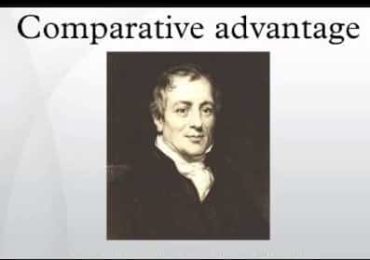In economics, Theory of Comparative advantage refers to the ability of a party to produce a particular good or service at a lower marginal and opportunity cost over another. Even if one country is more efficient in the production of all goods (absolute advantage in all goods) than the other, both countries will still gain by trading with each other, as long as they have different relative efficiency.

As per Theory of Comparative advantage, if, using machinery, a worker in one country can produce both shoes and shirts at 6 per hour, and a worker in a country with less machinery can produce either 2 shoes or 4 shirts in an hour, each country can gain from trade because their internal trade-offs between shoes and shirts are different. The less-efficient country has a comparative advantage in shirts, so it finds it more efficient to produce shirts and trade them to the more-efficient country for shoes. Without trade, its opportunity cost per shoe was 2 shirts; by trading, its cost per shoe can reduce to as low as 1 shirt depending on how much trade occurs (since the more-efficient country has a 1:1 trade-off). As per Theory of Comparative advantage the more-efficient country has a comparative advantage in shoes, so it can gain in efficiency by moving some workers from shirt-production to shoe-production and trading some shoes for shirts. Without trade, its cost to make a shirt was 1 shoe; by trading, its cost per shirt can go as low as 1/2 shoe depending on how much trade occurs.
Another example: Say you have John who makes $300 an hour and he hires a maid who works for $25 an hour. It takes John 1 hour to clean his house compared to his maid who takes 8 hours to clean his house. Then as per Theory of Comparative advantage John has an absolute advantage over his maid but the maid has a comparative advantage. This is because if John cleans his house by himself, he loses $300. If he hires the maid, he makes a profit of $100.
The net benefits to each country are called the gains from trade.
Conditions that maximize comparative advantage do not automatically resolve trade deficits. In fact, many real world examples where comparative advantage is attainable may require a trade deficit. For example, the amount of goods produced can be maximized, yet it may involve a net transfer of wealth from one country to the other, often because economic agents have widely different rates of saving.
As the markets change over time, the ratio of goods produced by one country versus another variously changes while maintaining the benefits of comparative advantage. This can cause national currencies to accumulate into bank deposits in foreign countries where a separate currency is used.
Macroeconomic monetary policy is often adapted to address the depletion of a nation’s currency from domestic hands by the issuance of more money, leading to a wide range of historical successes and failures.